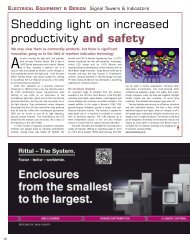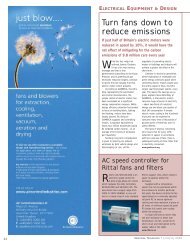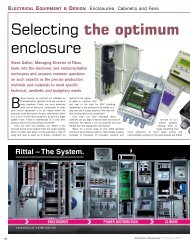sensors & systems - Industrial Technology Magazine
sensors & systems - Industrial Technology Magazine
sensors & systems - Industrial Technology Magazine
Create successful ePaper yourself
Turn your PDF publications into a flip-book with our unique Google optimized e-Paper software.
dealing<br />
with all the<br />
pressure<br />
you need<br />
fans and blowers for extraction, cooling,<br />
ventilation, aeration, vacuum and drying<br />
• Backward curved bladed single inlet<br />
centrifugal blowers<br />
• Flow rates up to 850m 3 /hr (500CFM)<br />
• Pressures upto 150mBar (60in.SWG)<br />
• Exceptionally low noise levels<br />
• Reliable and maintenance free<br />
• ATEX versions<br />
• Many configurations and add-ons<br />
ACI’s Multi Stage Range of directly driven blowers offers<br />
exceptionally quiet running and maintenance free<br />
solutions for many higher pressure applications.<br />
Direct mounting of the impellers and low motor speeds minimise<br />
noise levels whilst providing high pressure performance. The Multi<br />
Stage’s modular system design gives a flexible choice in the number<br />
of stages combined. Power supply options available.<br />
Please contact us for further detailed specifications and to<br />
discuss suitability for your application.<br />
www.aircontrolindustries.com<br />
the solution providers for air movement problems<br />
Air Control Industries Ltd<br />
Silver Street,<br />
T: +44(0)845 5000 501<br />
Chard,<br />
F: +44(0)845 5000 502<br />
Somerset,TA20 2AE, UK E: sales@aircontrolindustries.com<br />
ELECTRICAL EQUIPMENT & DESIGN<br />
Time to check<br />
your cable<br />
glands?<br />
Terry Spriggs of Hylec Components helps<br />
to keep your knowledge up-to-date by<br />
giving an overview of what has changed<br />
and what is now available<br />
There are now more<br />
variations of cable gland<br />
available than ever, and with<br />
more choice comes the<br />
requirement for more knowledge in<br />
order to make the right selection.<br />
Considerations such as suitability for<br />
purpose, sealing, safety and<br />
installation time all need to be<br />
balanced against cost, which is<br />
always an issue.<br />
It is as easy to overlook a cable<br />
gland as it is to under-specify or to<br />
over-specify it. With a huge range of<br />
fast new push-fit designs, tighter<br />
regulations and new materials<br />
coming onto the market it is essential<br />
to look at what is fit-for-purpose.<br />
Essential criteria include the quality<br />
of the hole available for the cable<br />
entry, the thickness of the cable, the<br />
ingress protection required, the<br />
mechanical cable retention strength<br />
required, and the environment it is<br />
being exposed to. Exposure to heat,<br />
weathering and any fire requirements<br />
such as building regulations, halogen<br />
free requirements, Ex rating or ATEX<br />
zones have to be considered.<br />
One of the original and simplest<br />
types of cable gland is the ‘stuffing<br />
gland’ offering basic sealing and<br />
protection for cables passing through<br />
panels or bulkheads. A locking nut is<br />
used to apply pressure via a skid<br />
washer onto the sealing rings that<br />
spread to form a seal around the<br />
cable. This method of cable feedthrough<br />
achieves three basic<br />
functions. It protects the cable from<br />
possible damage due to any sharp<br />
edges on the bulkhead/wall/cabinet.<br />
It provides a barrier to moisture and<br />
debris entering the equipment<br />
housing (IP ratings are generally low<br />
as they will not withstand<br />
pressurised water or immersion). And<br />
it provides a measure of cable<br />
retention. The stuffing gland has<br />
been around for many years and is<br />
used in an enormous number of<br />
applications today. However, a major<br />
problem with these particular types<br />
of traditional gland is the limited<br />
mechanical performance and its<br />
protection rating of IP54.<br />
Many applications require better<br />
cable retention, in terms of factors<br />
like superior mechanical strength, a<br />
wider clamping range and a higher<br />
rating of IP65, or IP68 (which can be<br />
buried and/or kept under full<br />
emersion in water). These needs are<br />
catered for by a dome topped cable<br />
gland. These glands are also more<br />
aesthetically pleasing, looking more<br />
modern and smartening up an<br />
installation. A number of variations of<br />
this type are available in both Nylon<br />
and metal but the salient features<br />
that ensure superior performance to<br />
the traditional stuffing gland are in its<br />
construction.<br />
The cable is again fed through a<br />
sealing ring but in this case, the<br />
sealing ring is placed within an 'iris'<br />
that closes onto the sealing ring,<br />
clamping the cable and forming a<br />
high IP seal as the dome top is<br />
screwed down.<br />
Dome top variations<br />
Many different cable gland variations<br />
exist in dome top configurations<br />
covering a variety of general<br />
industrial applications. Specialist<br />
applications may require additional<br />
protection over and above the<br />
common plastic variations. There<br />
are, for example, products designed<br />
to meet the requirement of ATEX<br />
100a for hazardous areas such as<br />
petrochemical. And there are glands<br />
designed for EMC compatibility and<br />
certified by VDE in compliance with<br />
VG 95373 part 40. Stainless steel<br />
versions should be considered in food<br />
and chemical process applications<br />
28 More details: Write in 280 on the free information card<br />
INDUSTRIAL TECHNOLOGY • May 2008
















